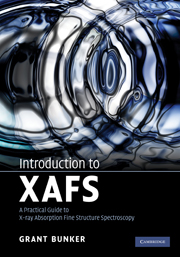Book contents
- Frontmatter
- Contents
- Preface
- 1 Introduction
- 2 Basic physics of X-ray absorption and scattering
- 3 Experimental
- 4 Theory
- 5 Data analysis
- 6 Related techniques and conclusion
- Appendix 1 Introduction to Fourier transforms in EXAFS
- Appendix 2 Cumulants in EXAFS
- Appendix 3 Optimizing X-ray filters
- Appendix 4 Reference spectra
- Appendix 5 X-ray tables
- References
- Index
3 - Experimental
Published online by Cambridge University Press: 25 January 2011
- Frontmatter
- Contents
- Preface
- 1 Introduction
- 2 Basic physics of X-ray absorption and scattering
- 3 Experimental
- 4 Theory
- 5 Data analysis
- 6 Related techniques and conclusion
- Appendix 1 Introduction to Fourier transforms in EXAFS
- Appendix 2 Cumulants in EXAFS
- Appendix 3 Optimizing X-ray filters
- Appendix 4 Reference spectra
- Appendix 5 X-ray tables
- References
- Index
Summary
Requirements for XAFS experiments
The features of interest in XAFS spectra consist of small variations in the absorption coefficient µ(E), which can be determined directly in a transmission experiment, or indirectly by measuring the variation in the intensity of specific fluorescence emission lines as the energy of the incident beam is scanned over an absorption edge. Sometimes useful information, such as edge shifts, can be obtained from XANES spectra that are noisy, but in general very good signal to noise ratio (S/N) is required for EXAFS analysis and detailed XANES analysis. For EXAFS measurements one requires S/N ratios better than 103 in order to determine the spectra accurately enough in the region ≈ 600–1000 eV above the absorption edge. It is generally necessary to measure spectra at least this far above the edge in order to get adequate spatial resolution. The EXAFS signal may damp out quickly above the edge because of disorder and/or low-Z scatterers, rapidly plunging the signal into the noise, unless the noise level is kept very low.
An intense beam is required to obtain good data in a reasonable time frame (minutes to hours): on the order 1010 photons/sec or better within the required energy bandwidth of an eV or so. For this reason, synchrotron radiation sources are by far the preferred sources of X-rays for XAFS experiments.
- Type
- Chapter
- Information
- Introduction to XAFSA Practical Guide to X-ray Absorption Fine Structure Spectroscopy, pp. 36 - 105Publisher: Cambridge University PressPrint publication year: 2010

